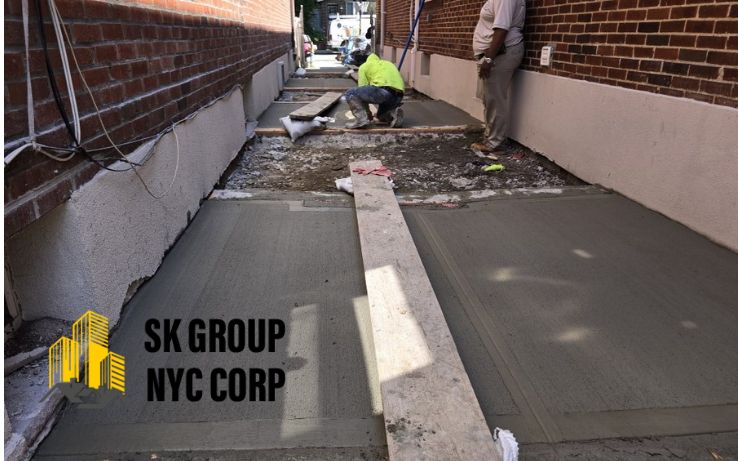Concrete is one of the most durable and versatile materials used in construction. Whether it’s for a driveway, patio, or foundation, proper Concrete Installation ensures strength, stability, and long-lasting results.
With the right preparation, mixing, and finishing, concrete can deliver professional-quality surfaces that stand the test of time. In this guide, we’ll walk you through every step of the Concrete Installation process to help you achieve the best results.
Table of Contents
Why Choose Concrete for Your Project?
Concrete is widely used for both residential and commercial construction projects. Here are some reasons why it’s a popular choice:
- Durability: Concrete is resistant to weather conditions, making it a reliable option for long-lasting structures.
- Affordability: Compared to other building materials, concrete is cost-effective.
- Versatility: It can be molded into various shapes and finishes, allowing for unique designs.
- Low Maintenance: Once installed, concrete requires minimal upkeep.
Preparing the Site for Concrete Installation
Before pouring concrete, the site must be properly prepared. This stage is crucial to prevent cracks, uneven surfaces, and other structural issues.
Step 1: Clear the Area
Ensure that the area is free of any debris, grass, rocks, or old structures. A clean and smooth surface is essential for a successful concrete installation.
Step 2: Build a Strong Foundation
To prevent future shifting or sinking, the foundation must be leveled and compacted. Typically, a layer of gravel is used as a base. The thickness of the gravel layer will depend on the specific project requirements.
Step 3: Set Up Forms
Forms are wooden or metal frames that contain the concrete as it dries. They act as barriers to shape the concrete into the desired structure. These should be installed securely to prevent any leaks or irregular shapes.
Mixing the Concrete
Once the site is prepared, the next step is mixing the concrete. There are two main methods for mixing concrete:
Manual Mixing
Manual mixing works well for smaller projects, such as pathways or small patios. Ensure you maintain the right ratio of cement, sand, and gravel to achieve a consistent mixture.
Ready-Mix Concrete
For larger projects, using ready-mix concrete proves ideal. A concrete plant pre-mixes this type of concrete and then delivers it to the site in a concrete truck. This process guarantees a uniform mixture and enhances efficiency for large installations
Pouring and Spreading the Concrete
Now that you’ve mixed the concrete, it’s time to pour it into the prepared site. Pour it in sections to ensure even distribution. After you finish pouring, use a concrete rake to spread the concrete evenly.
Screeding the Concrete
After pouring the concrete, screeding comes next. Use a long board or screed to level the surface, removing excess concrete and creating a smooth, even finish.
Finishing the Concrete Surface
After screeding, the concrete surface needs to be finished. This step involves smoothing and texturing the surface to give it the desired appearance.
Step 1: Floating the Concrete
Use a float to smooth the surface of the concrete. This tool evens out any ridges or imperfections left after screeding. Complete the floating process before the concrete begins to harden.
Step 2: Adding Texture
To prevent the concrete surface from becoming slippery, you should add texture based on the project requirements. Use a broom or textured roller to create grooves on the surface, ensuring better grip and safety.
Step 3: Edging
For a polished look, use an edging tool to smooth the edges of the concrete. This gives the project clean, finished lines.
Curing the Concrete
Curing is the process of allowing the concrete to harden and gain strength over time. Make sure to cure the concrete properly to prevent cracks and guarantee long-term durability..
Step 1: Cover the Concrete
Covering the concrete with a plastic sheet or damp cloth helps to retain moisture, which is critical for the curing process.
Step 2: Monitor the Curing Process
The curing process typically takes 28 days, during which the concrete will continue to harden. During this time, it’s important to avoid any heavy traffic or loads on the surface.
Common Mistakes to Avoid in Concrete Installation
When it comes to concrete installation, there are some common mistakes that can compromise the durability and appearance of the project. Here are a few pitfalls to avoid:
- Improper Site Preparation: Skipping the site preparation step can lead to uneven surfaces and cracks.
- Incorrect Concrete Mix: Using too much or too little water can weaken the concrete.
- Rushed Curing Process: Failing to allow the concrete to cure properly can result in weak, cracked surfaces.
Maintaining Your Concrete Installation
Once you install the concrete, maintain it properly to keep it in excellent condition for years to come. Here are a few tips to keep your concrete looking great:
- Sealing: Apply a concrete sealant to protect the surface from moisture and stains.
- Regular Cleaning: Use a pressure washer to clean the concrete surface and remove dirt and grime.
- Repairs: Address any cracks or chips immediately to prevent further damage.
Final Thoughts
Concrete installation is a multi-step process that requires attention to detail and proper technique. By following these guidelines, you can ensure a durable, long-lasting structure that will serve its purpose for years. Whether you’re working on a driveway, foundation, or patio, understanding the process of mixing, pouring, finishing, and curing concrete is essential for achieving professional results.
If you’re looking for expert concrete installation services, SK Group NYC Corp is here to help. We offer top-quality concrete solutions for both residential and commercial projects, ensuring long-lasting and professional results. Contact us for your next project, and let our team of experts handle the job with precision and care.
Have Questions? Call Us Now!
+1 (718) 507-7000
We’re here to help quick answers, friendly service, anytime you need!
Contact SK Group NYC
🌐 Website: www.skgroupnyccorp.com
📍 Serving: Manhattan, Brooklyn, Queens, The Bronx, and Staten Island
📍 Address: 87-88 172nd St, Jamaica, New York, NY, United States, New York

